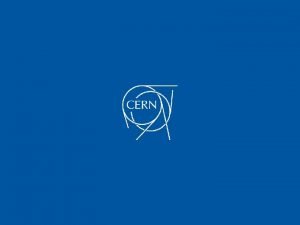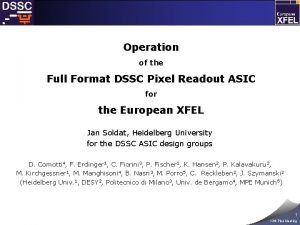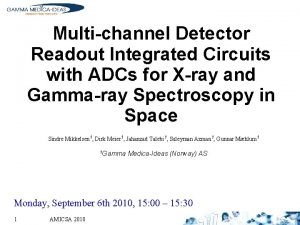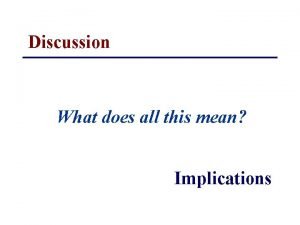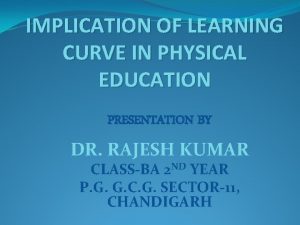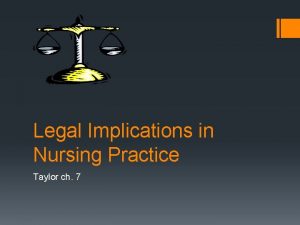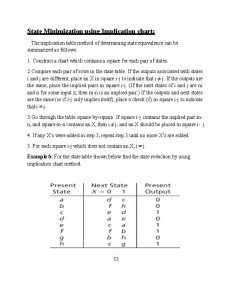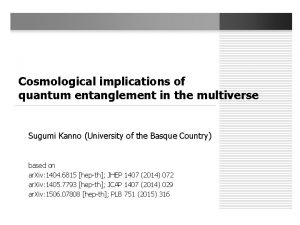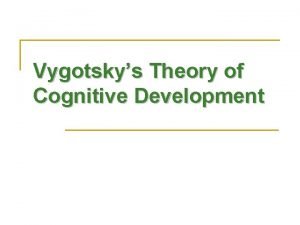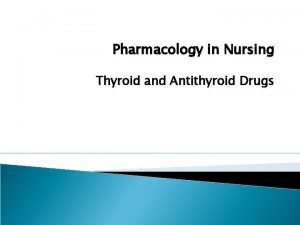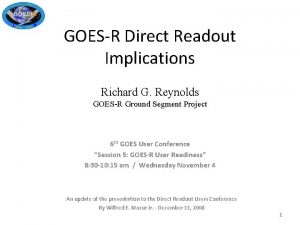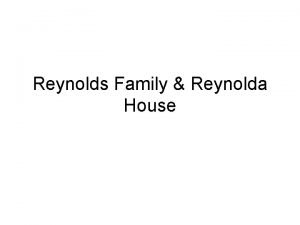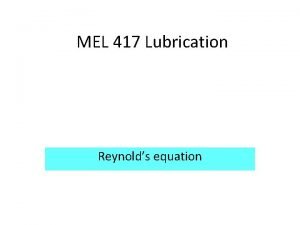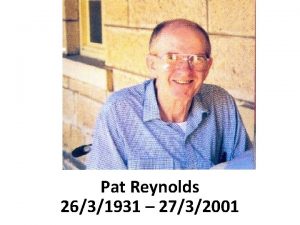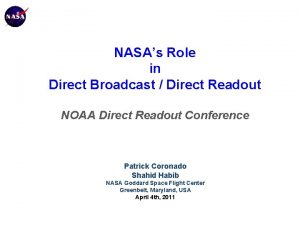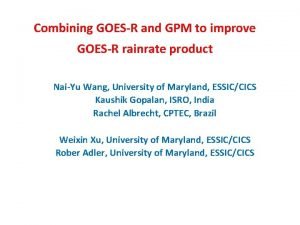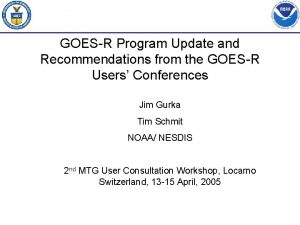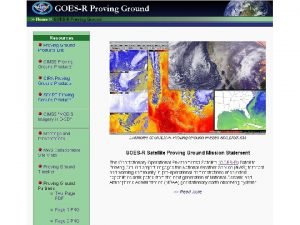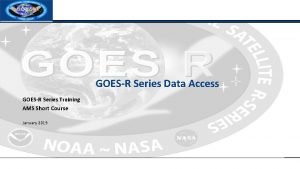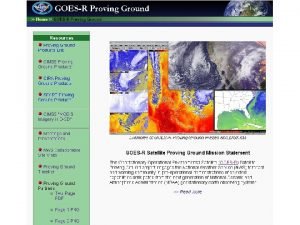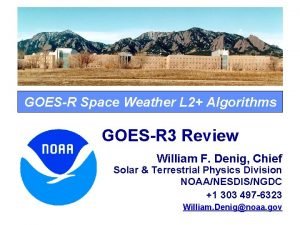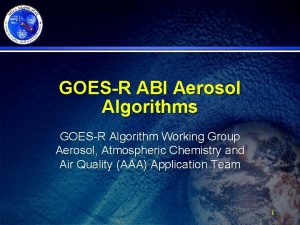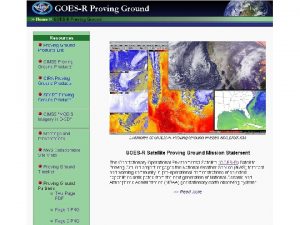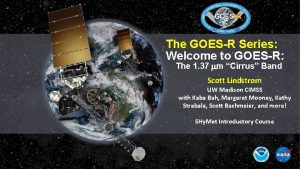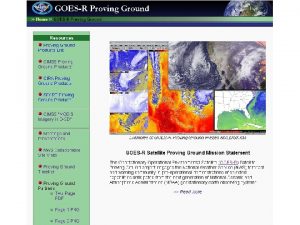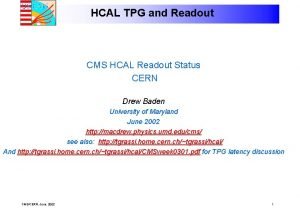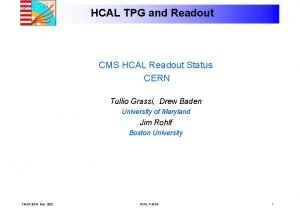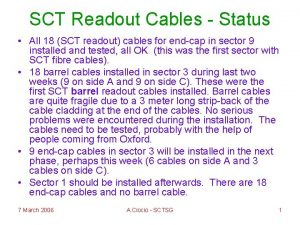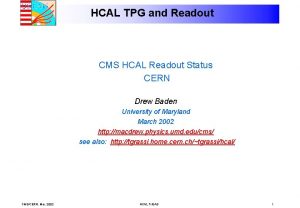GOESR Direct Readout Implications Richard G Reynolds GOESR









![GOES[-R] Rebroadcast (GRB) • Provides full resolution products from all instruments – All data GOES[-R] Rebroadcast (GRB) • Provides full resolution products from all instruments – All data](https://slidetodoc.com/presentation_image_h/80ed1fb32606dd444649ba41eca53aea/image-10.jpg)
![GOES[-R] Rebroadcast (GRB) (Continued) • LHCP to provide subset of imagery (ABI … 0. GOES[-R] Rebroadcast (GRB) (Continued) • LHCP to provide subset of imagery (ABI … 0.](https://slidetodoc.com/presentation_image_h/80ed1fb32606dd444649ba41eca53aea/image-11.jpg)


















- Slides: 29

GOES-R Direct Readout Implications Richard G. Reynolds GOES-R Ground Segment Project 4 th GOES User Conference “Session 5: GOES-R User Readiness” 8: 30 -10: 15 am / Wednesday November 4 An update of the presentation to the Direct Readout Users Conference By Wilfred E. Mazur Jr. - December 11, 2008 1

Topics • • • Direct Readout Services GOES-R Program Status New Instruments for GOES-R Frequency Plan Implications to Communications Services – – – – GRB and Dual Polarization GRB Receive Systems EMWIN & LRIT Become HRIT/EMWIN Emulated GVAR (e. GVAR) DCS SARSAT Multi-Use Data Link (MDL) 2

Direct Readout Services Overview GOES Rebroadcast (GRB) High Rate Information Transmission / Emergency Managers Weather Information Network Emulated GOES Variable (e. GVAR) Data Collection System (DCS) (HRIT/EMWIN) Search and Rescue Satellite Aided Tracking (SARSAT) 3

GOES-R Program Status • Instrument Contracts – ABI / SUVI / EXIS / SEISS / GLM – All Under Contract • Spacecraft Contract – July 22. 2009 – Lockheed-Martin – Denver, Colorado NNG 07193033 J, NNG 08193033 R / http: //prod. nais. nasa. gov/cgi-bin/eps/bizops. cgi? gr=D&pin=51 • Ground Segment Contract – May 27, 2009 – Harris Corporation – Melbourne, Florida DG 133 E-08 -RP-0068 http: //www. fedbizopps. gov • Antenna System Acquisition – October 22, 2009 – Proposals Received • GOES-R Access Subsystem (GAS) / Ancillary Data Relay System (ADRS) / HRIT/EMWIN “Domain-5” Upgrade / Data Collection System IF Compatibility – Soon – RFP Release • GOES-R Launch Readiness Date – September 2015 GOES-S Launch Readiness Date -- February 2017 4

GOES-West 137° West GOES-East 75° West a Dat & nd ma m o c ta o tr on Da Direct Readout Users ata d l, C Remote Backup Facility Fairmont, WV Command & control, data NOAA Satellite Operations Facility Suitland, MD Command Data Acquisition Station Wallops, VA 06/19/2008 v 2 GOES-R System Configuration • 5 5

Instrument Performance 6

Instrument Data Delivery 7

Instrument Raw Data Rate Comparison 8

GOES-R Frequency Plan DOWNLINKS (RAW DATA DOWNLINK AT 8220 MHz NOT SHOWN) HRIT/EMWIN BPSK 1697. 4 MHz DCPC CDMA SAR 468. 775 MHz FDM 468. 825 MHz 1544. 550 MHz DCPR FDM 1683. 3 MHz 1683. 6 MHz GRB (dual pol) 1690. 0 MHz CDA Telemetry BPSK 1696. 3 MHz DSN Telem & Rng BPSK/PM 2211. 04 MHz Radiosondes 1675 to 1683 MHz 470 1545 1670 1675 1680 DCPC CDMA 2032. 775 MHz 2032. 825 MHz UPLINKS DCPR FDM/8 PSK 401. 9 MHz 402. 2 MHz 400 1685 SAR FDM/Bi-Φ 406. 05 MHz 405 EMWIN-LRIT BPSK 2028. 4 MHz 2025 1690 1695 Command BPSK 2034. 2 MHz 2035 7210 2210 GRB (dual pol) 7220. 0 MHz Command Ranging BPSK 2036. 0 MHz 2030 1700 7215 7220 7225 9
![GOESR Rebroadcast GRB Provides full resolution products from all instruments All data GOES[-R] Rebroadcast (GRB) • Provides full resolution products from all instruments – All data](https://slidetodoc.com/presentation_image_h/80ed1fb32606dd444649ba41eca53aea/image-10.jpg)
GOES[-R] Rebroadcast (GRB) • Provides full resolution products from all instruments – All data will be calibrated and navigated (“Level 1 b”) – Except … GLM will be higher level products (“Level 2+”) • “Events, ” “Groups, ” and “Flashes” • Replaces current GVAR service – 31 Mbps vs. 2. 1 Mbps – DRO receive systems specified for same size antennas (G/T of 15. 2 d. B/K), however with significant changes: • • • New center frequency 1690. 0 MHz vs. 1685. 7 MHz High-level modulation (e. g. QPSK, OQPSK or 8 -PSK, TBD) vs. BPSK Dual polarization – requiring feed changes and dual receiver chain CCSDS packet formatting Forward error detection coding (LDPC) to reduce required C/No. DVB-S 2 link characteristics and compatibility under consideration – System specified for 2. 5 d. B margin 10
![GOESR Rebroadcast GRB Continued LHCP to provide subset of imagery ABI 0 GOES[-R] Rebroadcast (GRB) (Continued) • LHCP to provide subset of imagery (ABI … 0.](https://slidetodoc.com/presentation_image_h/80ed1fb32606dd444649ba41eca53aea/image-11.jpg)
GOES[-R] Rebroadcast (GRB) (Continued) • LHCP to provide subset of imagery (ABI … 0. 64, 3. 9, 6. 185, 7. 34, 11. 2, 12. 3, 13. 3 micron channels); • RHCP to provide remaining 9 ABI channels, plus all other instruments 11

GRB 99. 99% Availability Coverage Interference Level Interference level could be exceeded in the DARK BLUE area GOES West 0. 01% Exceedence of 22 d. B interference level based on “Initial Bound Equation” determined by the conducted measurements and the ITU-R 0. 01% rain rate for given areas in the GOES antenna footprint. GOES East Some locations near the equator may experience a reduced, but positive, margin under expected worst case conditions 12

One Concept for a GRB Small User Receive System Downconverter Data & Demodulator Aggregator Antenna & Feed Filter 90 deg Hybrid LNA Demodulator RHCP Data Handling Filter LNA LHCP DVB-S 2* PCI Card Receiver Demodulator Storage ~$750/polarization – $~300 for a PCI-Card –$450 for an equivalent new PC from Dell Data Aggregator $450 for an equivalent new PC from Dell 13

Emulated GVAR (e. GVAR) • As a contingency capability, and to give users additional time to transition from GVAR to GRB, e. GVAR will provide GOES-R Imagery to Users capable of receiving today’s GVAR data stream – Will be broadcast through a GOES I/P Series Satellite – The signal will have the GVAR characteristics: • Same transmit frequency (1685. 7 MHz) and power levels • Same GVAR data rate (2. 11 Mbps) and format • Five Similar Imager channel wavelengths (Based on ABI channels 0. 64, 4. 9, 6. 19, 11. 2, 13. 3 µm) • Imagery will be mapped to GOES NOP temporal and spatial resolution • No Sounder data • One full-earth disk every 30 -minutes – No Mesoscale data – No “Rapid Scan; ” No “Super Rapid Scan” 14

Emulated GVAR (e. GVAR) (Continued) – Not an option for long-term use – Will only be operational based on assessments of end user readiness near the time for GOES-R operations: • Presumes a spare satellite is available • Users must not be lax in preparing for actual GOES-R (i. e. , GRB) readiness 15

e. GVAR & GRB Flows GOES-R Satellite GOES-I/P Series Satellite GOESN/O/P RF Product Generation Product Gen GOES-N/O/P SSGS e. GVAR User GRB e. GVAR & GRB Legend Instrument Raw Data downlink GRB relay uplink e. GVAR relay uplink GRB RF Broadcast e. GVAR RF Broadcast Terrestrial/Network Comm GRB User 16

HRIT/EMWIN • Successor to individual Low Rate Image Transmission broadcast (LRIT) and the Emergency Managers Weather Information Network broadcast (EMWIN) combined onto one carrier. • Frequency change from 1691. 0 MHz/1692. 7 MHz to 1694. 7 MHz • Higher data rate … 921 Kbps) • Provides growth path for both Services to a combined 400 Kbps – LRIT currently 128 Kbps – EMWIN currently: – 9. 6 Kbps (GOES 11&12), 19. 2 Kbps for GOES 13 -15. • Will utilize BPSK modulation w/ convolutional and Reed. Solomon coding – Same as LRIT, but higher data rate – Allows maximum EIRP from satellite due to Power Spectral Density restrictions – EMWIN Users modulation type changes from uncoded FSK (GOES I-M) and from coded OQPSK (GOES-NOP) to coded BPSK at much higher data rate. 17

HRIT/EMWIN (Continued) • Name change to High Rate Information Transmission (HRIT) required by CGMS categorization of services • Virtual Channel Data Units used to separate HRIT and EMWIN data – CCSCS Virtual channels as used in LRIT today • Prototype “Software Defined Radio” developed and demonstrated: – One hardware/software configuration can receive all current and future EMWIN, LRIT and HIRT/EMWIN signals with NO hardware changes or upgrades (GOES I-S compatible). No user transition necessary. – Technology demonstration to proves low cost, PC-based terminals are possible for all data rates and modulation types – Performance data, Hardware design and software design is available on WWW. GOES-R. GOV – Development performed for GOES-R Program by Aerospace Corp. – Presentation and Demonstrations provided last night 18

HRIT/EMWIN Ground Data Flow (Per satellite) GOES-R GS RF Up/Down Ant. /RF HRIT/EMWIN Uplink & Signal Monitoring IF Switch IF Modulation Uplink Processor (Domain 5) WCDAS HRIT/EMWIN CCSDS TCP/IP Comm Processor NSOF (Domain 4) RBU EMWIN From NWS HRIT From ESPC RF Up/Down Ant. /RF HRIT/EMWIN Uplink & Signal Monitoring IF Switch IF Modulation Uplink Processor (Domain 5) HRIT/EMWIN CCSDS TCP/IP (B/U) GOES-R GS 19

GOES Data Collection System • 20

GOES Data Collection System • GOES-DCS consists of two communication Services: – Data Collection Platform Receive (DCPR) – Data Collection Command (DCPC) … Previously “Interrogate” (DCPI) • GOES-R will support the ongoing evolution toward greater channel efficiency and system capacity – Narrower DCPR channel assignments allowing both East and West satellites to each support 200 simultaneous platform signals, with a total system capacity of about 72, 000 platforms – A new DCPC service, based on CDMA techniques, currently in prototype development. This user-funded development concept will allow one command channel on each GOES NOP Series satellite and two channels on each GOES-R Series satellite • Direct Broadcast of DCPR to User systems having 15. 0 G/T will continue to be supported, but …. 21

GOES Data Collection System (Continued) • Summary of Changes to GOES-DCS for GOES-R Series: – DCP uplink transmit power reduced, in accordance with latest DCP Certification Specifications – DCPR uplink frequencies will be unchanged – DCPR Downlink frequencies will be shifted from 1694. 51694. 8 MHz to 1683. 3 -1683. 6 MHz • Will require change in channel demodulator frequency – DCPI becomes DCPC: • Will be compatible with on-going User-funded developments compatible with current satellites • Able to support a second DCPC channel 22

SARSAT • 23

SARSAT • Signal characteristics of the SARSAT service will be slightly modified for GOES-R: – Up and down-link center frequencies remain the same – GOES-R will transpond, rather than re-modulate, the up-link band – Will require configuration changes to the LUT receiver • To account for degraded Beacons, GOES-R will operate with 32 d. Bm uplink power (versus 36 d. Bm for GOES-NOP) – Provides improved capability to support beacons with weak signals – Transponder will also operate with a minimum of 10 uplink beacons simultaneously – Conforms to COSPAS/SARSAT Specification T 001, Issue 3 Revision 8 dated Nov 2007 24

Other Changes of Potential Interest • All raw instrument data will be transmitted to the ground in X-Band vs. today’s S-Band – X-band provides ‘spot beam’ geographical coverage vs. hemispheric – Processed to Level 1 B and re-broadcast to users via the GRB link • Diagnostic telemetry will be available via a new higher data rate telemetry link (32 Kbps) – “CDA” telemetry downlink changes from 1694. 0 MHz to 1696. 3 MHz • The Multi-use Data Link (MDL) is eliminated for GOES -R Series 25

Summary • System requirements, communications requirements, and the Ground Segment architecture have been defined for the entire system, including Direct Readout Services • Detailed definition of communication link characteristics have not yet been fully finalized and will be refined through the Spacecraft and Ground Segment contract design processes … However the GOES-R baseline is: – GRB will replace all current forms of instrument data broadcast: • • Full resolution Geo-located Calibrated In essentially real-time – EMWIN and LRIT will be combined and enhanced to a higher data rate on a new downlink frequency – HRIT/EMWIN – DCS will remain largely the same, however DCPR downlink in L-Band will have a frequency shift – SARSAT will be essentially unchanged 26

Summary (Continued) • Documentation for the Direct Readout User community will be produced by the GOES-R Ground System contractor as CDRLs. – Of particular note, the GS Contractor (Harris Corporation) will be developing a Product User's Guide (PUG) that will include a section on building a GRB receive system 27

Back-up • 28

GOES N/O/P Frequency Plan DOWNLINKS DCPI BPSK 468. 825 MHz SAR FDM and ± 12. 5 k. Hz 1544. 550 MHz 470 1545 EMWIN QPSK 1692. 7 MHz Radiosondes use 1675 to 1683 MHz SD UQPSK 1676. 0 MHz 1670 1675 PDR MDL BPSK QPSK 1681. 478 MHz 1685. 7 MHz 1680 400 SAR FDM/Bi-Φ 406. 05 MHz 406. 025 MHz 405 PDR 2. 11 Mbps 2027. 7 MHz 2025 CDA Telem Bi-Φ 1694. 0 MHz DSN Telem BPSK/PM 2209. 086 MHz DCPR FDM/8 PSK 1694. 5 MHz 1694. 8 MHz 1685 UPLINKS DCPR FDM/8 PSK 401. 9 MHz 402. 2 MHz LRIT BPSK 1691. 0 MHz 1690 Command BPSK 2034. 2 MHz 1695 2210 EMWIN QPSK 2034. 7 MHz DCPI BPSK 2034. 8875 MHz 2034. 9000 MHz 2034. 9125 MHz LRIT BPSK 2033. 0 MHz 2030 1700 2035 29
 Readout units
Readout units Readout device
Readout device Full pixel readout
Full pixel readout Readout integrated circuit
Readout integrated circuit King richard iii and looking for richard
King richard iii and looking for richard Chapter 23 legal implications in nursing practice
Chapter 23 legal implications in nursing practice Constructivist approach to language learning
Constructivist approach to language learning Legal implications of social media
Legal implications of social media Mechanism of antifungal drugs
Mechanism of antifungal drugs How audience negotiate meaning in mil
How audience negotiate meaning in mil What is legal implications
What is legal implications Discussion and implications
Discussion and implications Educational implications of learning curve
Educational implications of learning curve Marketing implications
Marketing implications 5 educational philosophies
5 educational philosophies Legal dimensions of nursing practice
Legal dimensions of nursing practice Ranexa nursing implications
Ranexa nursing implications Implication chart method
Implication chart method Implications of nativist theory
Implications of nativist theory Marketing implications
Marketing implications Epistemology of existentialism
Epistemology of existentialism Implications of quantum entanglement
Implications of quantum entanglement Nursing implications
Nursing implications Future implications definition
Future implications definition Guided participation vygotsky examples
Guided participation vygotsky examples Novolog nursing implications
Novolog nursing implications Nursing implications for synthroid
Nursing implications for synthroid Implications of nativist theory
Implications of nativist theory What is tautology in math
What is tautology in math Trends and issues in nursing
Trends and issues in nursing
